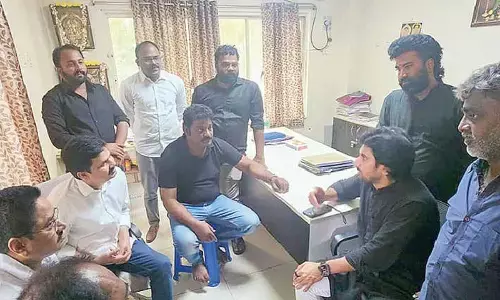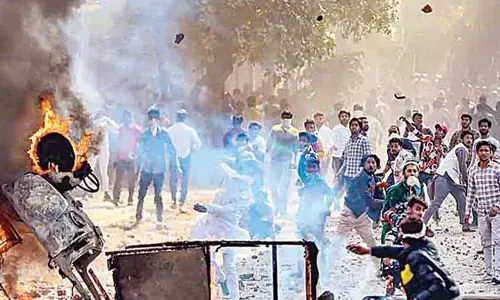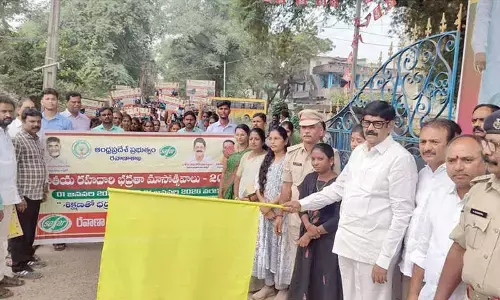Paddy cultivation area drops significantly in Nellore dist

Paddy cultivation in Nellore
Farmers opt for other crops as they are worried over not getting MSP
Lack of Minimum Support Price for paddy is the main cause for the farmers following undeclared crop holiday for the last couple of years.
Cost of paddy in other States is cheaper when compared to Nellore district and the local millers are not showing interest in exports and thus confining themselves to nominal procurement.
Paddy is normally grown in around 5 lakh hectares in the district. However, the area of cultivation in recent times has gone down to 1 lakh to 1.5 lakh hectares.
In fact, paddy cultivation occupied 97 pc of area covered in 2013-14 with 1.92 lakh hectares out of normal area of 1.98 lakh hectares in the district. The situation was also good during 2014-15 where 90 pc of area was covered with paddy crop to the tune of 1.78 lakh hectares out of total area of 1.98 lakh hectares. Paddy was cultivated in around 2.90 lakh hectares in 2015 exceeding the normal area, 1.50 lakh hectares in 2016 and 1.08 lakh hectares in 2017.
Even though officials had promised water for 2-3 lakhs acres for the second crop, farmers started cultivation in only 50,000-60,000 acres in 2022 against the expected acreage. This typical situation prevailed in the district due to the fear of losses and majority farmers kept lands barren even though district administration assured water for 2-3 lakh acres for the late kharif season.
During rabi, pad dy cultivation was taken up in about 2 lakh hectares. Now, farmers stopped cultivating paddy during other than regular season and the area reduced to 60,000 acres from 1 lakh acres. This area is also gradually decreasing due to reduction in per capita rice consumption where people are preferring millets, and other grains with low carbohydrates.
Even though BPT varieties were much welcomed by the consumers in the State, they are not suitable for local conditions and scientists developed NLR 145 (Swarnamukhi), MT 1001, MT 1010, NLR30491 (Bharani), NLR 33358 (Somasila), NLR 34449 (Nellore Mahsuri) and NLR 40024 (Swetha) for local needs.
However, immediately after the State government had announced supply of quality rice to the ration cardholders through the PDS, farmers showed interest in the cultivation of the Nellore Masuri variety again. Consequently, demand for NLR 34449 paddy variety, which is a slender one, has significantly increased. Normally, the district gets paddy stocks of 10-15 lakh MTs per annum.
"Earlier, people used to consume only millets in villages and consumption of rice increased subsequently due to supply of subsidized rice in 80s. Now, due to no interest in rice, the government is also incurring expenditure for storing stocks in warehouses and stocks are also getting damaged. Even though we developed advanced varieties of paddy considering difficulties of farmers, consumers are preferring millets and the government is also encouraging alternative crops," said Dr P Ramesh Babu, retired scientist from Acharya Ranga Agriculture University.
CSR Koti Reddy, State president of Confederation of Indian Farmers Associations, said, ""Irrigation Advisory Board assured water for 2-3 lakh acres but farmers are not interested in taking up sowing. Water is available, and there is no scarcity for seeds and other inputs. But they are worried over getting MSP for their produce."
Millers procure 1,100-1,200 kg from the farmers against 850 kg of putty, and the farmers suffer a loss of Rs. 3,000-4,000 per putty, he added. Consequently, the cultivating area in the district has gradually been reducing due to numerous factors.
Farmer AV Ramanaiah Naidu from Indukurpet mandal said farmers suffered huge losses during previous season. He said out of planned 15 lakh MT of paddy only 3 lakh MT of paddy was only procured by the government through RBKs last year.
The rest of the stocks were purchased by millers offering Rs. 11,000-13,000 per putty against the MSP of Rs 16,600 plus, he added. On the other hand, millers say it is expensive exporting rice to other countries offering MSP to the farmers due to availability of stocks at a comfortable cost in other nearby states.








